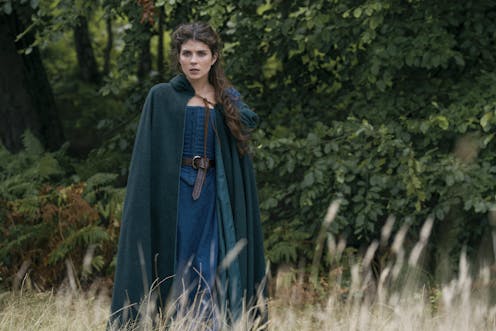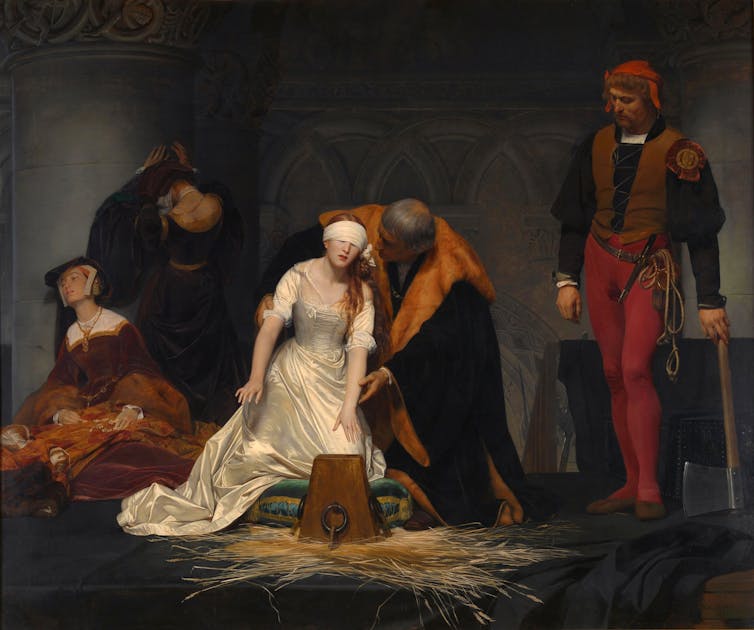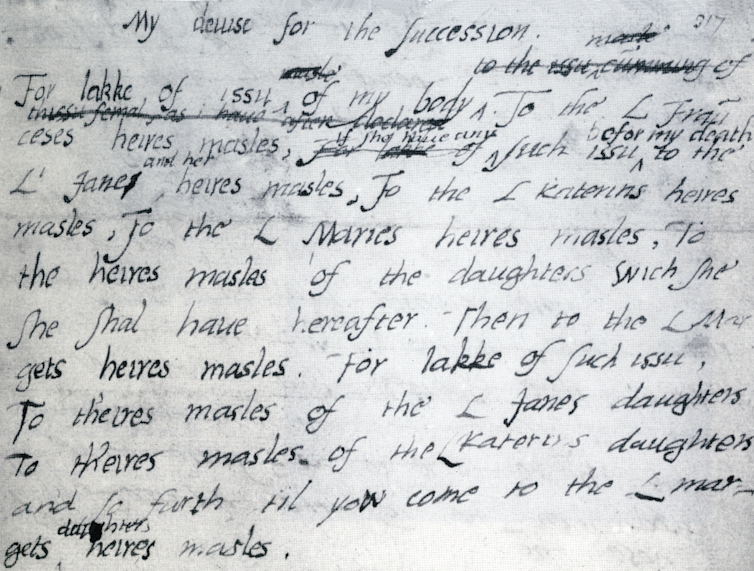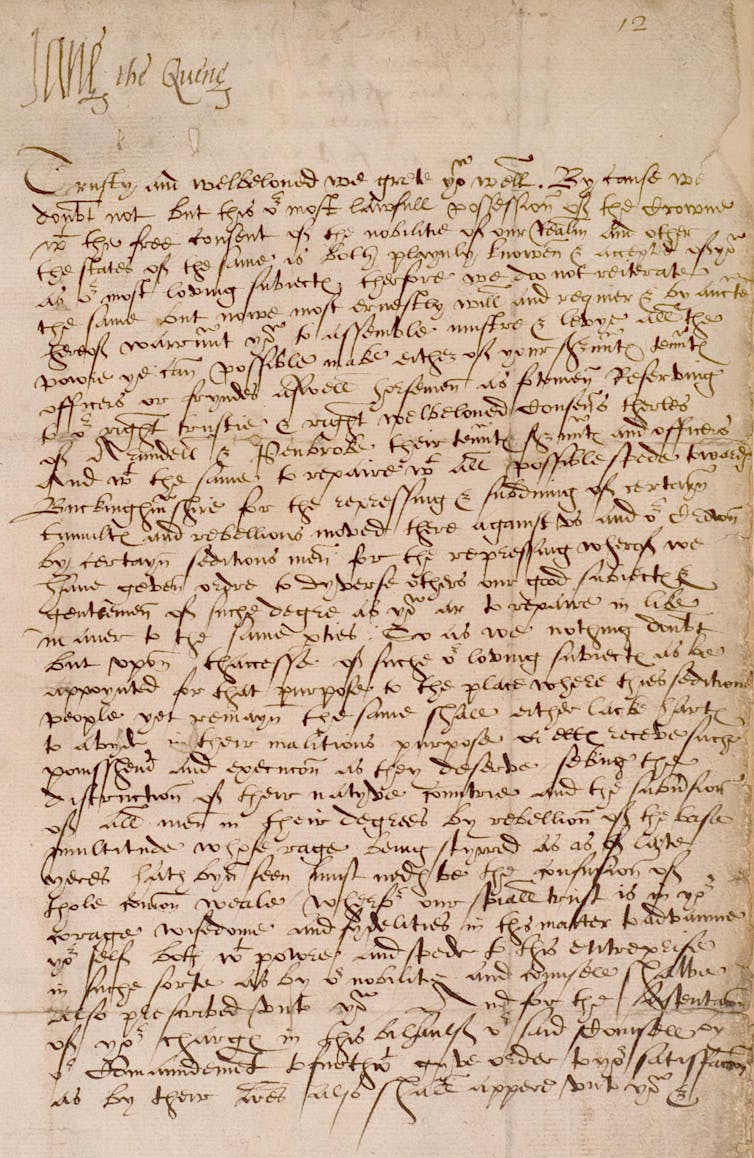Source: The Conversation (Au and NZ) – By Susan Broomhall, Director, Gender and Women’s History Research Centre, Australian Catholic University

History remembers Jane as the ultimate damsel in distress – known for her death, rather than her life. Fuck that! What if history were different?
So says the promo for My Lady Jane, an alternative history about Lady Jane Grey who was Queen of England, France and Ireland for little more than a week in July 1553.
This avowedly “alt-universe of action, history, fantasy, comedy and steamy romance” series, as the press release calls it, takes all sorts of liberties, but in some ways, it may be closer to the mark than we might imagine. These fictional women are almost as feisty as the historical Jane and her cousin, Mary, who would become Queen Mary I.
Jane has often been portrayed as a tragic figure. In this, the French painter Paul Delaroche has a lot to answer for. His 1833 visual melodrama, The Execution of Lady Jane Grey, remains a powerful image attached to her history.
Delaroche’s romanticised vision seemed to capture the pathos of a young woman blindly following expectations and sacrificed to dynastic politics – establishing its own influential alt-history.

Wikimedia Commons
So what do we know about Lady Jane Grey?
The great-granddaughter of Henry VII and great-niece of Henry VIII, Jane had access to an unusually rich humanist education for a woman of her time and demonstrated an exceptional ability to make use of it, writing letters in Latin and Greek and learning Hebrew. This made her the talk of Protestant Europe.
For Jane, studying seemed an escape from the pressures of her parents. She told one scholar she found studying with her tutor a relief from being in the presence of an exacting mother and father, time when “I think myself in hell”.
Jane’s commitment to Protestantism saw her writing to one of continental Europe’s leading reformer, Zurich-based Heinrich Bullinger, before she was 14.
But Protestantism in England was under threat. By mid 1553, 15-year-old King Edward VI was dying. Edward’s heir was his Catholic, older half-sister Mary, who, if she were to reign, looked set to undo the Protestant kingdom.
At stake for Mary and Jane, two strong-willed women, were competing visions of faith for the kingdom of England. Under Mary, England would return to the Catholic Church. Under Jane, England would continue along the course of Protestantism, launched by her great-uncle Henry VIII.
Edward’s solution was to disinherit his sisters, and to pass the crown to Jane and her future male heirs.
But Edward’s draft plan for his succession suggests there was some uncertainty about whether placing Jane as queen was the right idea. After all, England had no history of successful ruling queens. He had first written that the crown would go to “L Janes heires masles”, and then amended it to read “L Jane and her heires masles”.

Wikimedia Commons
When Edward died on July 6 1553, the letters patent issued regarding his will bore the signatures of more than 100 of the kingdom’s leading men. Supporters of the Protestant vision for England held almost all key positions of power.
On July 9, Jane, aged only 15 or 16, was informed of Edward’s death and her new status. On July 10, she was proclaimed Queen, signing herself “Jane the Quene” on official documents.

Wikimedia Commons
But Mary was not giving up. She had been gathering supporters in the days before Edward’s death. On July 10 she wrote to the Privy Council, England’s leading body of men advising the monarch, informing them she was queen and expected their obedience. She had gathered a large army behind her, and what likely sealed her success was the work of a faction combining Catholics and conservatives in the Privy Council who flipped the council’s allegiance to Mary.
Jane’s support rapidly collapsed. The kingdom’s powerful men must have weighed their prospects in the two regimes, and most could likely find a place to operate in either.
Winner takes all
As she took the throne, Mary needed a way to explain away Jane. She was to be tried for high treason, but she was also a relative.
A Jane misguided by others was a convenient version of history.

Wikimedia Commons
At first, Mary spared the execution warranted by the guilty verdict for both Jane and her equally youthful husband, Guildford Dudley. But further attempts at rebellion in January 1554, led by Jane’s father, pushed Mary to carry out the sentences.
Even then, Mary postponed Jane’s execution date to allow her time to convert to Catholicism. Jane refused, expressing her resolve for the same beliefs that had guided her decisions and actions.
On February 12 1554, Jane stood on the scaffold. She gave a speech that claimed both her innocence and her guilt.
Perhaps, as she saw Mary’s version of history increasingly take root, she wanted to assert her own.
And so we are left with a story of the tragic teen queen vs bloody Mary. As the promo says: “there is always power, if you know how to play the game” – and this game didn’t end with Jane’s death.
![]()
Susan Broomhall receives funding from the Australian and Swedish Research Councils.
– ref. A woman who blindly conformed or feisty creator of her own story? What we know about the real Lady Jane Grey – https://theconversation.com/a-woman-who-blindly-conformed-or-feisty-creator-of-her-own-story-what-we-know-about-the-real-lady-jane-grey-232831







